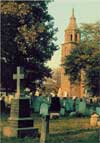





Survey of
Historic Sites and Buildings
 |
ST. PAUL'S CHURCH NATIONAL HISTORIC SITE New York |
 St. Paul's Church NHS7 |
| ||
St. Paul's Church was founded in 1665, not long after the founding of the village in 1642 by freedom-loving refugees from Puritan Massachusetts under Anne Hutchinson. Her consistent stand during her life, and her death in 1643 at the hands of Indians, created something of a reaction in the Colonies in favor of religious freedom and tolerance. Later the "Great Election of 1733" here led to the famous trial of John Peter Zenger, his vindication, and a reaction in favor of freedom of the press. Connected in these and other ways with the history of civil liberties in the United States, the present effort toward the protection and preservation of St. Paul's Church is being spearheaded by the Society of the National Shrine of the Bill of Rights. The objectives of the society are to assist in the upkeep of the church, to restore the village green in front to its colonial appearance, to help maintain the planned Zenger Memorial Museum Building, and to carry on educational activities.
The present structure of stone and brick was started in the 1760's and evidently not completed until after the War for Independence. It is of simple Georgian colonial style and replaced an earlier wooden structure, said to have been destroyed for firewood when the newer church was used as a hospital and barracks by Hessian troops. In its tower hangs Freedom Bell, 1,800-pound twin of the more famous Liberty Bell at Independence Hall, Philadelphia. Freedom Bell was cast in 1752 by the same foundry that manufactured the Liberty Bell, and it was preserved during the Revolutionary War by being buried secretly, along with other precious objects belonging to the church. The entire area along the Boston Post Road was ravaged severely by armed men of both sides during the war. About a hundred Hessians were buried in a mass grave, now marked, in the cemetery. Other identifiable graves in the cemetery date from as early as about 1700.
St. Paul's Church was restored faithfully to its 1787 appearance in 1942 as the result of work of a committee of eminent citizens headed by Mrs. Sara Delano Roosevelt. It was designated a National Historic Site in 1943. It has been faced by serious problems of maintenance because of the industrial nature of its modern environment and its lack of religious function since the former congregation has joined the recent trend in the evacuation of cities to the suburbs. While the restoration initially succeeded in reviving the congregation, by the 1970s the parish had dwindled to only a handful of worshippers. The last regular Sunday service at St. Paul's occurred in May 1977. In 1980, the site was transferred from the Episcopal Dioceses of New York to the National Park Service. The site opened to the public in 1984 and is operated under a cooperative agreement with the Society of the National Shrine of the Bill of Rights at Saint Paul's Church, Eastchester.
 |
 |
http://www.cr.nps.gov/history/online_books/colonials-patriots/sitea11.htm
Last Updated: 09-Jan-2005